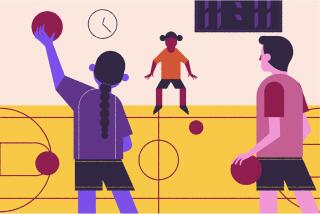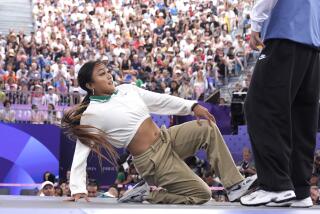Changing the Face of Hockey’s Future a Never-Ending Process
- Share via
Nearly every player in the NHL began his career in a predominantly white youth program. Some started as young as 4, rarely playing against any players of color.
But youth hockey is slowly changing. Such organizations as the Detroit Hockey Assn., Ice Hockey in Harlem and Disney GOALS work to include minorities in a sport traditionally dominated by whites.
“I think that’s great because I don’t think in sports, race or religion should come into play,” said King Coach Larry Robinson, 45, who has been associated with hockey for most of his life as a player or coach. “There’s enough racism in the world, and it shouldn’t come into play in any sport.”
To help create more opportunities for children of color to learn the sport, the NHL and USA Hockey have teamed to form a diversity task force. Started in 1994, the task force supports programs across the country and last year produced the first Willie O’Ree all-star game.
Named after the NHL’s first black player, the midseason event made up of 22 kids selected from programs in 11 cities nationwide will hold its second game next month in Chicago.
“Five or 10 years ago, many black and other minority kids did not have access to hockey,” said Bryant McBride, the NHL’s director of new business development. “Now, we’re trying to give them a channel to the game, and we’re doing it with programs that not only teach them how to play but also keep kids off the street.”
The diversity task force, however, realizes that it can only do so much in getting more kids exposed to the sport.
“It would be terrible for USA Hockey or the NHL to take credit for what’s going on,” said Lou Vairo, the director of special projects for USA Hockey and the coach of the 1984 U.S. Olympic hockey team. “There were four or five programs already in existence before we came along, and in order for [more minority kids] to keep playing, it is going to take the people in their communities to keep making things possible. People have to make it work.”
The oldest and probably most successful program geared for inner-city kids is the Detroit Hockey Assn., headed by Marvin Hicks, a former football player who did not play hockey growing up.
Started in 1969 with 67 kids, the program--which used to be named after former Detroit Red Wing coach and general manager Jack Adams--now has more than 400 youths, primarily blacks--on 25 teams--including several traveling teams.
Sponsored by the city of Detroit and its Police Athletic League, the program has turned out four national championship age-group teams and has one former player, Akil Adams, currently playing in the International Hockey League.
“We’re still at the point where we are educating the hockey world that blacks follow and can play the sport,” said Hicks, whose son, Marvin Jr., is one of the top players in the program. “Once anyone comes to our arena and watches our kids play, they are simply amazed. And it is only going to get better because there has been a marked increase in participation every year.”
The success of the DHA’s program has been so great that competing predominantly white programs have started recruiting DHA players and putting them on their traveling age-group teams.
“What they’ve found out is that we have a lot of kids with NHL-caliber talent if they can get the training and exposure,” said Hicks, who has a full-time job with the state of Michigan as a youth specialist and does not get paid for his work with DHA. “So they come and steal our players” by offering more exposure and financial help for expenses.
The DHA charges each child $150 a year for equipment, uniforms and travel, but other programs like Disney GOALS do not charge anything.
Dave Wilk, who started Ice Hockey in Harlem, was recruited by Disney to help create its GOALS program two years ago. Ice Hockey in Harlem celebrated its 10th anniversary in November and has about 175 kids now playing. Nine players have gone on to receive prep school scholarships.
Based in Anaheim, the GOALS program goes beyond teaching kids how to play hockey.
“We’re just trying to do anything to show kids, who normally would never get the chance, that there is a bigger world out there,” said Wilk, whose program is made up primarily of Latino children from poor neighborhoods in Orange County.
“Everything is provided for them, where we have a host of activities for them every day. Not only do we have ice and roller hockey programs, but we also have academic tutoring and many community service functions.”
There are 75 kids participating in the GOALS program this year, and Wilk says that its goal goes beyond producing hockey players.
“We give them a chance to be a part of something, just like we did in Harlem,” Wilk said. “We use hockey as the hook. We try to give them long-term hope.”
More to Read
Go beyond the scoreboard
Get the latest on L.A.'s teams in the daily Sports Report newsletter.
You may occasionally receive promotional content from the Los Angeles Times.






